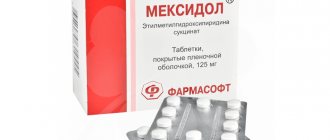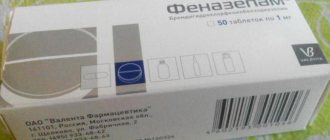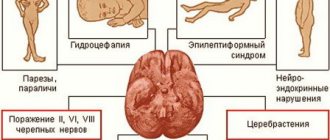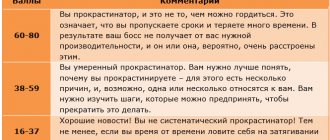Immunization against a dangerous disease - polio - is carried out with two types of vaccines: IPV (inactivated) and OPV (oral) polio vaccine. IPV, unlike OPV, does not contain live viruses. The drug is prepared on the basis of viral particles processed using physical and chemical methods. Killed poliovirus is not capable of causing disease, but helps develop stable specific immunity. For vaccinations, imported polio vaccine Imovax Polio or Poliorix is used.
Features of live and non-live polio vaccines
There are 2 types of vaccines: live and non-live (inactivated).
In Russia, both types are used simultaneously for prevention. The first two vaccinations are given with an inactivated strain of the virus, and the next ones with a live one according to the approved scheme. Live vaccine is used only in the Russian Federation. Doctors do not have a clear opinion which vaccine composition is better. Children's reactions can be completely different. The live vaccine has contraindications. It should not be given to children suffering from allergic reactions, because... it contains foreign (chicken) protein.
In addition, although the strain of the virus that the drug contains is weakened, there is still a risk of negative consequences and complications in the form of vaccine-associated polio. An immunized child sheds the virus and can be a source of infection for children in contact with him.
On the other hand, it is the live vaccine that provides vaccine recipients with more reliable protection against polioviruses due to the formation of humoral and local immunity. It is given to children in the form of drops under the tongue, which eliminates painful reactions.
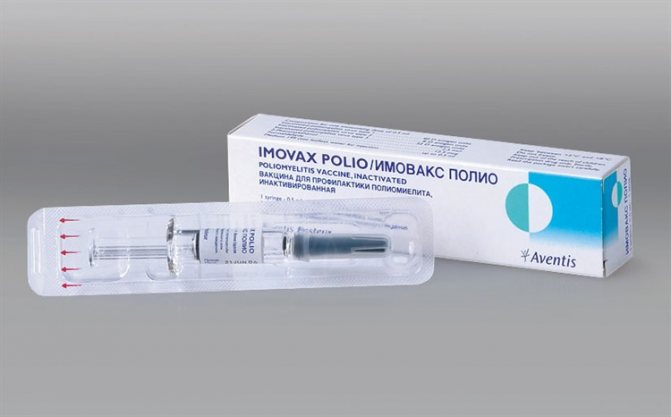
Vaccine Imovax Polio
A non-live (inactivated) vaccine may contain a killed (dead) virus of one or two strains. In Russia, they use the drug Imovax Polio (France), Poliorix (Belgium), as well as combined vaccination formulations Pentaxim, Tetracok, Tetraxim, Infanrix Penta, Infanrix Hexa.
They form good strong immunity, but are very painful. IPV is administered by injection into the thigh or shoulder area. The use of inactivated vaccines containing a virus that has already been killed and has no reproductive activity eliminates the risk of complications in the form of vaccine-associated poliomyelitis. An immunized child will not be contagious.
In Russia, vaccination of children is free, but parents can also use a paid scheme, which should be agreed upon in advance with the local pediatrician.
How to prepare for immunization?
Before vaccination, the following conditions and points must be observed and taken into account:

- the vaccine should only be administered to a healthy child;
- The vaccine cannot be given if the child has a fever or has had contact with children who are carriers of viral diseases (chickenpox, mumps, rubella);
- Allergy sufferers should not have exacerbations at the time of immunization;
- It is advisable to take a general blood test in advance, which can provide important information about your health status;
- a couple of days before the procedure it is necessary to monitor the condition of the intestines.
You must also follow the following preparation rules:
- dress the baby so that he does not sweat. Before going to the doctor, you can take a short walk;
- before vaccination, the child should not be fed heavily, you can limit yourself to drinking only;
- it is important to have as little contact with other children as possible;
- It is advisable to consult your pediatrician and medical staff about possible reactions;
- more than one vaccination should not be given in one day;
- The vaccination schedule must be strictly followed.
Parents can control the immunization process and the quality of the vaccine used.
Diagnostics
When making a diagnosis, clinical, epidemiological, serological and virological data should be taken into account:
- spinal puncture (increased pressure of cerebrospinal fluid, leukocytes - neutrophils, increased protein content);
- general blood test (signs of inflammation: leukocytosis, increased ESR);
- throat washes and culture on a nutrient medium;
- fecal analysis with culture;
- culture of blood and CSF on a nutrient medium;
- determination of antibodies in blood serum (no less than a fourfold increase in antibody titers in paired sera taken in the acute stage of the disease and after 1–3 weeks);
- electroencephalogram and MRI (give nonspecific results and are only of relative importance for diagnosis).
Instructions for use of polio vaccine composition
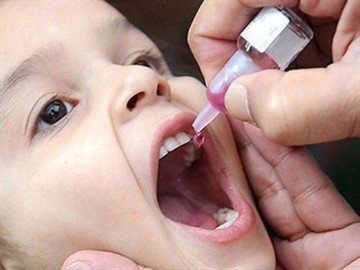
The polio vaccine is intended to prevent infection. It contains attenuated strains of the virus of three types, which are obtained in laboratory conditions from cells taken from the kidneys of a special species of African monkeys.
The drug contains the preservative kanamycin as a stabilizer. The vaccine is administered strictly orally, the child receives 4 drops at a time, and the regimen itself involves taking the composition six times.
The vaccination course includes the first three vaccinations, revaccination is carried out three times according to the approved calendar:
- vaccination - at 3, 4.5 and 6 months;
- revaccination - at 18, 20 months and 14 years.
Reducing the intervals between the first three vaccinations is unacceptable. It is possible to shorten the period between the stages of vaccination and revaccination, but the difference between taking the drug and the approved regimen should be no more than 3 months. Extending the intervals between vaccinations is allowed only for medical reasons in exceptional cases.
Contraindications for use
Vaccination, like other vaccines, has its limitations and contraindications. These include:
- the presence of congenital or acquired immunodeficiency. The presence in the immediate environment of people with such a diagnosis, since vaccinated children shed the virus for some time, which poses a serious danger to those whose immunity is weakened;
- The vaccine is not given to children with malignant neoplasms during chemotherapy. Medical withdrawal is 6 months after undergoing such treatment;
- pregnancy and lactation period;
- acute illnesses, exacerbations of some chronic diseases. Immunization is carried out after complete recovery;
- contraindications are any manifestations of neurological reactions to an already administered vaccination;
- presence of allergies to Kanamycin, Streptomycin, Polymyxin B, which are used in vaccines as preservatives.
The polio vaccine rarely causes any complications. According to Dr. Komarovsky, live and inactivated vaccines are safe. The only serious complication is vaccine-associated polio.
To prevent complications, the first two vaccinations are carried out with an inactivated vaccine, which allows the child to develop immunity sufficient to protect against VAP.
Treatment of polio is extremely difficult, which is why it is so important to be vaccinated against this virus.
Side effects and complications

There are practically no negative consequences after vaccination. If you follow doctors' recommendations, the drug should be well tolerated.
Sometimes allergic reactions occur in the form of redness and skin rashes, and Quincke's edema occurs extremely rarely. Sometimes dangerous vaccine-associated paralytic poliomyelitis is registered in vaccinated people or in people in contact with them, but these are isolated cases.
Contacts of a vaccinated child with others, as well as with people suffering from immunodeficiency diseases, should be limited.
Parents' opinions
Currently, the opinion about the dangers of vaccination for children's health is being popularized among parents. This also applies to the polio vaccine. Parents are increasingly wary of or even reluctant to strengthen their children's immunity through vaccination.
On all kinds of forums and websites you can see heated debates and reviews from mothers who have encountered the negative consequences of vaccinations. However, such cases are in the minority. Since those parents whose children underwent vaccinations safely, as a rule, do not visit these resources, and a picture emerges that does not correspond to reality, that is, the vector of public opinion is shifting in the negative direction unreasonably.
Is quarantine necessary, and how does vaccination against polio with live vaccine affect others?
After vaccination, the child secretes the virus for another 60 days.
But since the strain is weakened, it cannot cause disease in healthy children. When an unvaccinated healthy child comes into contact with a vaccinated child, so-called passive immunization occurs; it can be expressed by cold symptoms, which go away on their own and quickly.
The danger remains only for children with severe immunodeficiency and neurological diseases.
Children immunized with a live vaccine do not pose a threat to healthy people, so quarantine is not required.
Precautionary measures
The oral vaccine would not have become so widespread if the risk of severe infection was high. Don't panic: the likelihood of post-vaccination complications is extremely low. But since it exists, precautions should be taken.
The fight against cancer greatly reduces immunity; such people are at risk.
If all family members are healthy , then there are three simple rules for childhood vaccinations:
- Follow hygiene rules more carefully than usual - wash your hands more often, eat from isolated dishes, do not share items such as towels, toothbrushes or toys.
If there are several children in a family, they all need to be vaccinated at once: this way the risk practically disappears.
After the injection, refrain from visiting institutions such as kindergartens and crowded places in general, because the child is a potential carrier of the infection.
The chance is very small, and if simple recommendations are followed, it tends to zero.
Poliomyelitis (infantile spinal palsy, Heine-Medin disease) is an acute and severe infectious disease that is caused by poliovirus, which affects the gray matter of the anterior horns of the spinal cord and other parts of the central nervous system.
Poliomyelitis predominantly affects children and adolescents. The danger of the disease is the development of paralysis.
Video on the topic
About non-live and live polio vaccines in the video:
Poliomyelitis is an extremely severe viral disease that leads to irreversible paralysis. The disease is insidious and can be asymptomatic or with mild symptoms during the incubation period.
And only mass planned vaccination can create a reliable barrier to the spread of this disease. In Russia it is free and absolutely safe. The live vaccine used for vaccinations has almost no contraindications and is well tolerated by children.
What kind of disease is this
Poliomyelitis is an acute infectious disease caused by the poliovirus hominis virus, which belongs to the group of enteroviruses, that is, intestinal viruses.
The disease is characterized by high contagiousness, that is, there is a high probability of infecting a random person with the disease.
The gray matter in the spinal cord is affected, leading to depression of the central nervous system and muscle paralysis.
At risk are children aged six months to seven years - they are the ones most likely to develop pathologies, but older people can also get sick.
Future US President Franklin Roosevelt suffered from polio at the age of thirty-nine!
A child of kindergarten age is prone to violating the rules of cleanliness, and in countries with a low level of sanitary culture, morbidity rates have always been higher.
Parents should be wary if they observe the following symptoms:
- temperature up to 39-40 °C;
headaches and muscle pain;
indigestion: nausea, vomiting, abnormal bowel movements, loss of appetite.
The incubation period lasts from three days to a month , usually about ten days - during this period the virus spreads throughout the body.
Forms of poliomyelitis depending on the nature of pathogenesis:
- Spinal – the upper parts of the spinal cord are affected, up to the lumbar.
Bulbar - effects on the nuclei of the cranial nerves inside the spinal cord trunk.
Pontine - the nucleus of the facial nerve is affected.
Mixed forms, as derivatives of those listed.

